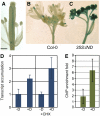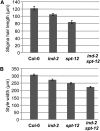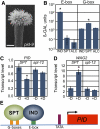INDEHISCENT and SPATULA interact to specify carpel and valve margin tissue and thus promote seed dispersal in Arabidopsis
- PMID: 21990939
- PMCID: PMC3229140
- DOI: 10.1105/tpc.111.090944
INDEHISCENT and SPATULA interact to specify carpel and valve margin tissue and thus promote seed dispersal in Arabidopsis
Abstract
Structural organization of organs in multicellular organisms occurs through intricate patterning mechanisms that often involve complex interactions between transcription factors in regulatory networks. For example, INDEHISCENT (IND), a basic helix-loop-helix (bHLH) transcription factor, specifies formation of the narrow stripes of valve margin tissue, where Arabidopsis thaliana fruits open on maturity. Another bHLH transcription factor, SPATULA (SPT), is required for reproductive tissue development from carpel margins in the Arabidopsis gynoecium before fertilization. Previous studies have therefore assigned the function of SPT to early gynoecium stages and IND to later fruit stages of reproductive development. Here we report that these two transcription factors interact genetically and via protein-protein contact to mediate both gynoecium development and fruit opening. We show that IND directly and positively regulates the expression of SPT, and that spt mutants have partial defects in valve margin formation. Careful analysis of ind mutant gynoecia revealed slight defects in apical tissue formation, and combining mutations in IND and SPT dramatically enhanced both single-mutant phenotypes. Our data show that SPT and IND at least partially mediate their joint functions in gynoecium and fruit development by controlling auxin distribution and suggest that this occurs through cooperative binding to regulatory sequences in downstream target genes.
Figures








Similar articles
-
SPATULA and ALCATRAZ, are partially redundant, functionally diverging bHLH genes required for Arabidopsis gynoecium and fruit development.Plant J. 2011 Dec;68(5):816-29. doi: 10.1111/j.1365-313X.2011.04732.x. Epub 2011 Sep 19. Plant J. 2011. PMID: 21801252
-
The bHLH transcription factor SPATULA enables cytokinin signaling, and both activate auxin biosynthesis and transport genes at the medial domain of the gynoecium.PLoS Genet. 2017 Apr 7;13(4):e1006726. doi: 10.1371/journal.pgen.1006726. eCollection 2017 Apr. PLoS Genet. 2017. PMID: 28388635 Free PMC article.
-
Functional domains of SPATULA, a bHLH transcription factor involved in carpel and fruit development in Arabidopsis.Plant J. 2008 Jul;55(1):40-52. doi: 10.1111/j.1365-313X.2008.03469.x. Plant J. 2008. PMID: 18315540
-
Gynoecium and fruit development in Arabidopsis.Development. 2022 Mar 1;149(5):dev200120. doi: 10.1242/dev.200120. Epub 2022 Feb 28. Development. 2022. PMID: 35226096 Review.
-
The role of auxin in style development and apical-basal patterning of the Arabidopsis thaliana gynoecium.Plant Signal Behav. 2009 Feb;4(2):83-5. doi: 10.4161/psb.4.2.7538. Plant Signal Behav. 2009. PMID: 19649177 Free PMC article. Review.
Cited by
-
Morphologically and physiologically diverse fruits of two Lepidium species differ in allocation of glucosinolates into immature and mature seed and pericarp.PLoS One. 2020 Aug 25;15(8):e0227528. doi: 10.1371/journal.pone.0227528. eCollection 2020. PLoS One. 2020. PMID: 32841235 Free PMC article.
-
The Roles of BLH Transcription Factors in Plant Development and Environmental Response.Int J Mol Sci. 2022 Mar 29;23(7):3731. doi: 10.3390/ijms23073731. Int J Mol Sci. 2022. PMID: 35409091 Free PMC article. Review.
-
Gynoecium size and ovule number are interconnected traits that impact seed yield.J Exp Bot. 2020 May 9;71(9):2479-2489. doi: 10.1093/jxb/eraa050. J Exp Bot. 2020. PMID: 32067041 Free PMC article. Review.
-
A model for an early role of auxin in Arabidopsis gynoecium morphogenesis.Front Plant Sci. 2014 Jul 8;5:327. doi: 10.3389/fpls.2014.00327. eCollection 2014. Front Plant Sci. 2014. PMID: 25071809 Free PMC article.
-
The Shock of Shatter: Understanding Silique and Silicle Dehiscence for Improving Oilseed Crops in Brassicaceae.Plant Direct. 2025 Apr 13;9(4):e70058. doi: 10.1002/pld3.70058. eCollection 2025 Apr. Plant Direct. 2025. PMID: 40230828 Free PMC article. Review.
References
-
- Alvarez J., Smyth D.R. (1999). CRABS CLAW and SPATULA, two Arabidopsis genes that control carpel development in parallel with AGAMOUS. Development 126: 2377–2386 - PubMed
-
- Alvarez J., Smyth D.R. (2002). CRABS CLAW and SPATULA genes regulate growth and pattern formation during gynoecium development in Arabidopsis thaliana. Int. J. Plant Sci. 163: 17–41
-
- Balanzá V., Navarrete M., Trigueros M., Ferrándiz C. (2006). Patterning the female side of Arabidopsis: The importance of hormones. J. Exp. Bot. 57: 3457–3469 - PubMed
Publication types
MeSH terms
Substances
Grants and funding
LinkOut - more resources
Full Text Sources
Molecular Biology Databases

